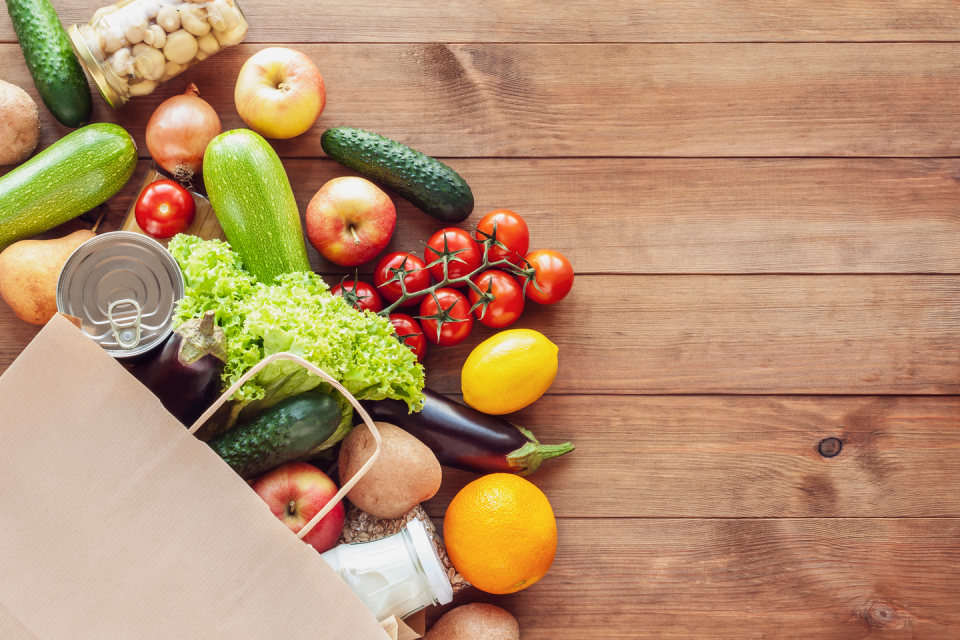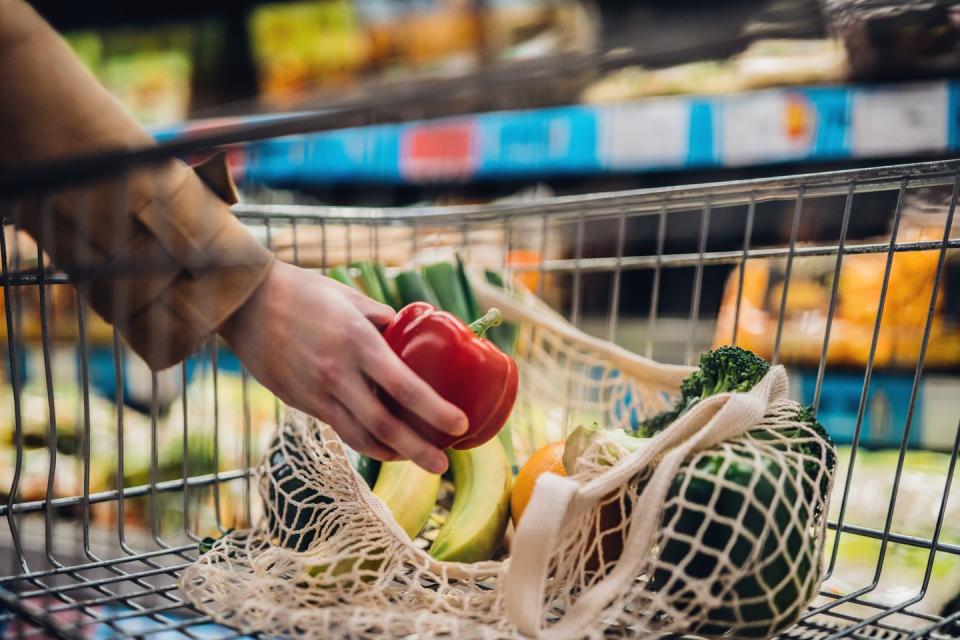16 Smart Tips to Save Money on Your Groceries
Feeding your family is complicated enough without worrying about the cost of groceries. Alas, this is the world we live in. If you're feeling a particularly sharp pinch at the supermarket, you're not alone—inflation and continued supply chain issues are impacting consumers in countries across the world. Luckily, there are plenty of ways to spend less and avoid unnecessary waste.
Take it from Ree Drummond: she hosted Big Bad Budget Battle, a cooking competition show based on how to save money on groceries and whip up family meals. And just like many of us, Ree didn't just pop into the world knowing how to make a perfect, money-saving grocery list. "I'm not a planner, so I came by my method by trial and error," she says.
Her solution? "About once a year, I go to a warehouse club and buy things in bulk, like flour, rice, beans, canned whole tomatoes, and M&M's." She types up her list and brings it along. How else do you think Ree keeps such a well-stocked and organized pantry? "If you don't take a list to a warehouse club, you end up buying a bulk pack of cotton candy!" Well, ain't that the truth. 😂
Here, you'll find out how to save money on groceries with advice and home-cooking wisdom from Ree, along with money-saving tips from financial experts Barbara O'Neill, Ph.D., CFP, CEO of Money Talk, and Lynnette Khalfani-Cox, personal finance adviser, author, and founder of The Money Coach. Let's get that grocery list started.

Take stock of what's in your pantry and fridge.
Ree proves that everyday, affordable ingredients can make mouthwatering food. Shop smart by starting in your own pantry. "Any good home cook knows you've got to know what you have on hand before you go to the supermarket," says Ree on her show, Big Bad Budget Battle. This allows you to avoid unnecessary purchases and plan meals around the produce or leftovers you already have. "Take the leftovers and reimagine them into something totally new."
Make a shopping list.
Plan out the week's meals ahead of time and make a detailed list of what you need. Doing so saves time in the store, which means you're less likely to make unnecessary impulse buys. In the same line of thought, try to plan meal prep recipes with overlapping ingredients. Why use half a bushel of cilantro for one meal and half a bushel of basil for another?
Budget for an impulse buy.
Everybody makes impulsive purchases once in a while. Rather than set an unrealistic goal, Barbara suggests working the possibility of an impulse buy into your shopping budget. For example, if your budget is $75 for weekly groceries, make a shopping list with $60 worth of items you need. Add $15 on the end for an unknown item. "That way, you give yourself permission to grab something that wasn't on your list, and you're not surprised by an extra cost at checkout," she adds. And if you don't spend the $15 one week? Well, you just saved some money.
Use apps and technology to your advantage.
Lynnette and Barbara note that coupons are a great tool for saving money, but paper versions are a bit less available now. In addition to physical coupons, download your favorite grocery store's app, which often features special sales or specific bargains. Sign up for their alerts and notifications, so you have the info ready when you walk into the store. Lynnette also suggests web browser add-ons like PriceBlink, which scans the internet for the lowest price and available coupons.

Shop by unit price.
The unit price (total cost divided by number of units) is often listed in the left-hand corner of the shelf label above the item price. Use that to your advantage, and find out which version of the item actually costs the least. "It might not sound like a lot," says Lynnette, "but the difference between $2 versus $3 a pound of meat is a 50% price difference. That adds up, and you can save yourself 50% just by paying attention." Unit price is especially handy to look at when deciding if you want the larger or smaller version of an item—chances are, the larger version will cost less per unit.
Plan more vegetable-forward meals.
Oops! Nobody tell Ladd, but Barbara has a fair point! Meat is expensive, particularly beef and lamb. But that doesn't mean you have to switch to tofu. "Instead of using meat as the main entree, make it a component. Use smaller pieces of meat in stir fry or pasta," she suggests. (Phew, okay—we can get on board with that!) Or try Meatless Mondays, a growing trend that helps introduce families to meat-free meals by having them once a week.
Go generic.
Of course you want to buy that big-name national brand! It feels so familiar! This is called "brand recognition" in business talk, and it's very lucrative. "The in-store brand from your supermarket or grocery chain is going to be a lot cheaper than what you're going to get from a manufacturer who has to pay for advertising, shipping, or shelf space," Lynnette says.

Buy whole vegetables.
Look, we get it: pre-chopped vegetables and fruits are a godsend on busy weeknights. A container of chopped onions or peeled garlic saves precious time, but they also tend to cost more than whole produce. If you want to save on groceries, avoid pre-prepped produce. Instead, invest in long-term kitchen tools that do the work for you like food choppers, mandolins, and garlic crushers.
Keep an eye out for sales and two-for-one deals.
An attractive sale or two-for-one deal is perfect for stocking up for the future (if it's not perishable). This will save you money in the long run.

Cut down on the sweets and junk food.
Don't cut the nutritious stuff if you have to buy less food. You always need dinner, you can save money by making dessert a special thing. While you're at it, avoid a large cart and go for a basket or a smaller cart. "The bigger the cart, the more you're likely to fill it up with items," says Lynnette.
Take stock of costly grocery delivery fees.
Lynnette explains, "Grocery delivery is certainly necessary for many people, but if you can shop in person, you'll save money." While it became a habit for many during the pandemic, "you have to realize you're paying a premium on that service," she continues. If you do decide to use the service, make sure you get your money's worth with larger order sizes and place fewer orders to cut down on fees.
Join a wholesale or warehouse store.
As Ree said, warehouse stores are magical places for home cooks. You can get amazing deals on dry goods that last you all year long! Barbara recognizes that membership might not make sense for smaller families, so she also suggests splitting the membership with another family if you can.

Check for shrinkflation.
Shrinkflation is when the price of an item hasn't changed, but there is less in the package than you're used to. When this happens, manufacturers have basically raised their prices by giving you a fraction of the amount. "You first have to be mindful of it and then be willing to switch to other brands," Lynnette says. "Typically, you will find less shrinkflation with those generic store brands." A good way to compare? Shop by unit price!
Beware of grouping.
Grouping is when stores typically put three or more related items together to try to make you want to purchase all of them. For example, you head to the store for chips and see that they're grouped next to salsa and dip. Your initial intention was to buy a bag, but now you're considering purchasing more items than needed.
Don't shop at eye level.
"Placement is everything," Barbara says. "It's been well documented that the more expensive items tend to be right eye level so people we'll see them." Check the lower and higher level shelves first to see if those brands or similar items are cheaper.
Beware the end cap.
End caps are those displays that highlight items between isles. This marketing tactic highlights items you weren't necessarily looking for and might impulsively buy. Before throwing these in your basket, consider why you're buying them. Do you really want it? If so, that's your weekly impulse buy. If not, put it back.
You Might Also Like

